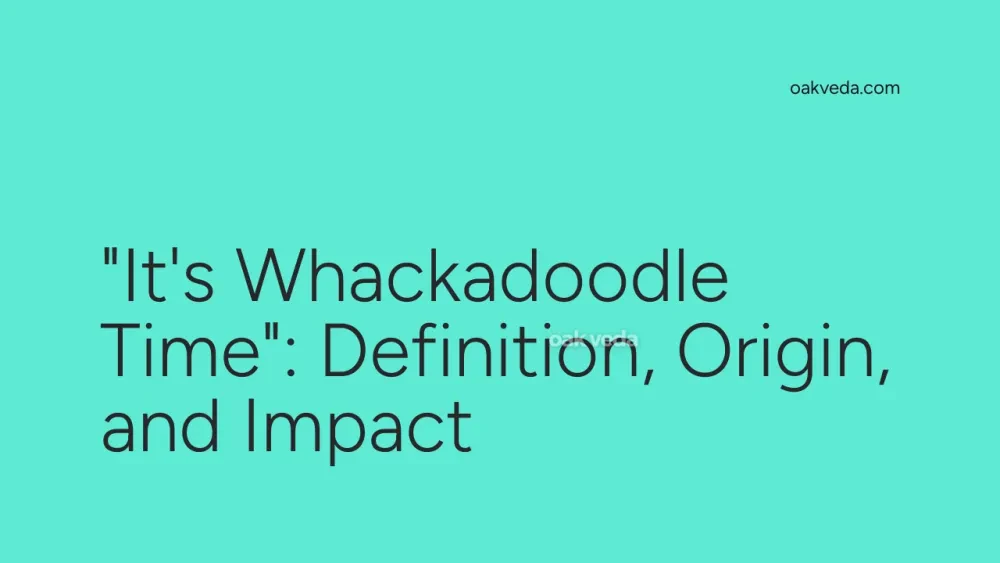
What is "It's Whackadoodle Time"?
"It's whackadoodle time" is a playful expression that has gained popularity on social media platforms. This phrase is used to convey a sense of silliness, absurdity, or lighthearted craziness in online interactions. When someone declares "It's whackadoodle time," they're essentially signaling that things are about to get fun, weird, or unpredictable.
Origin and Development of "It's Whackadoodle Time"
The term "whackadoodle" itself is a combination of two words: "whack" (meaning crazy or eccentric) and "doodle" (often used to describe something whimsical or nonsensical). While the exact origin of "It's whackadoodle time" is unclear, it has evolved as part of internet slang and meme culture.
The phrase gained traction on platforms like Twitter, TikTok, and Instagram, where users embraced it as a way to introduce humorous or offbeat content. Its popularity can be attributed to its versatility and the way it encapsulates the often zany nature of social media interactions.
How "It's Whackadoodle Time" Works
When someone posts "It's whackadoodle time" on social media, it serves several purposes:
- Setting the tone: It prepares followers for content that might be unconventional or silly.
- Creating engagement: The phrase often piques curiosity, encouraging others to interact with the post.
- Expressing creativity: Users might follow up with unusual memes, jokes, or stories.
- Building community: It can create a sense of shared humor among followers.
Popular Examples of "It's Whackadoodle Time"
The phrase is often accompanied by various types of content:
- Bizarre meme compilations
- Funny pet videos with unexpected twists
- Unusual DIY projects or life hacks
- Quirky dance challenges on TikTok
- Absurd photoshop edits or digital art
Impact of "It's Whackadoodle Time" on Social Media Culture
"It's whackadoodle time" has contributed to shaping a more playful and uninhibited social media culture. Its impact can be seen in several ways:
- Encouraging creativity: The phrase gives users permission to think outside the box and share unconventional ideas.
- Fostering positivity: By promoting lighthearted content, it helps create a more jovial online atmosphere.
- Breaking monotony: In a sea of curated content, "whackadoodle" moments provide refreshing breaks.
- Building personal brands: Some influencers have incorporated the phrase into their online personas, using it as a signature catchphrase.
How Brands and Influencers Use "It's Whackadoodle Time"
Savvy marketers and content creators have recognized the potential of "It's whackadoodle time" to engage audiences:
- Product launches: Brands might use the phrase to introduce quirky new products or unconventional marketing campaigns.
- Content series: Influencers often create "whackadoodle" themed content series, promising followers regular doses of entertaining, offbeat material.
- Community engagement: Companies use it to encourage user-generated content, asking followers to share their own "whackadoodle" moments.
- Brand voice development: Some brands incorporate the phrase to cultivate a more approachable, fun-loving image.
Future Trends Related to "It's Whackadoodle Time"
As social media continues to evolve, we can expect "It's whackadoodle time" and similar phrases to adapt:
- Platform-specific variations: Different social media platforms might develop their own unique "whackadoodle" equivalents.
- AI-generated whackadoodle: With advancements in AI, we might see tools that generate "whackadoodle" content on demand.
- Virtual reality whackadoodle: As VR becomes more mainstream, "whackadoodle time" could translate into immersive, bizarre virtual experiences.
- Whackadoodle analytics: Brands might start tracking "whackadoodle" engagement as a metric for measuring audience connection and content virality.
FAQs about "It's Whackadoodle Time"
-
Is "It's whackadoodle time" appropriate for professional settings? While it's primarily used in casual online interactions, some companies with a playful brand image might incorporate it judiciously.
-
Can "It's whackadoodle time" be overused? Like any internet trend, overuse can lead to fatigue. It's best used sparingly for maximum impact.
-
Are there any negative connotations to "It's whackadoodle time"? Generally, it's seen as a positive, fun phrase. However, context is key, and it should be used thoughtfully.
-
How can I incorporate "It's whackadoodle time" into my social media strategy? Use it to introduce lighthearted content, encourage user engagement, or signal a departure from your usual content style.
-
Is "It's whackadoodle time" specific to any particular age group? While it's popular across various age groups, it tends to resonate more with younger, social media-savvy audiences.
In conclusion, "It's whackadoodle time" has carved out its niche in the ever-evolving landscape of social media language. It represents the internet's love for the absurd, the creative, and the unexpectedly delightful. As online culture continues to shape our daily interactions, phrases like this serve as reminders of the joy and spontaneity that social media can bring to our digital lives.
You may be interested in:
- Meme: Definition, Origin, and Impact on Social Media
- Say Less: Definition, Origin, and Impact on Social Media
- @-Me: Definition, Origin, and Impact on Social Media
- Blue Checkmark: Definition, Origin, and Impact on Social Media
- Social Media Manager: Definition, Origin, and Impact
- That Girl: Definition, Origin, and Impact on Social Media

